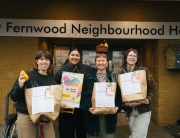›› Lee Herrin
Ten years ago on August 1st, 2005 Fernwood NRG (then the Fernwood Community Centre Society) took possession of the Cornerstone Building (1301-1313 Gladstone Avenue). Although it is hard to believe, things were very different in Fernwood then. The Cornerstone Building had been boarded up for over a year, neighbourhood businesses were struggling, the injection drug trade had penetrated the neighbourhood leaving discarded needles in the streets, and Fernwood was being called an “inner-city neighbourhood.”
As well, we were fighting rearguard actions half a block away at the Community Centre—vandalism and petty crime increased dramatically, meaning we were also spending resources just to maintain the status quo. And we weren’t succeeding.
People were steering clear of the dangerous corner at Fernwood and Gladstone, and were avoiding Fernwood Square. The George and Dragon (now the Fernwood Inn) sat nearly empty after dark, if you can believe it. The neighbourhood was dying on the inside.
It was demoralizing to be involved—I was serving on the organization’s Board of Directors and my name was at the top of the list for security call outs. My phone would ring once or twice a month in the middle of the night as our security company reported on break-ins. On at least three occasions I came down in the middle of the night to sit in an empty building waiting for the glazier to repair a window that had been smashed in just for sport, or to steal some relatively valueless items. People wondered why we kept on, but those of us who were involved at the time had a sense that things could be better if only we could find the answer.
We sat down and took stock in the spring of 2005. We made a list of our commitments which became our Declaration of Principles and Values. At the time they seemed like empty promises, and even today few organizations have a list of commitments as radically aspirational as ours. We did a hard-headed analysis and determined that we needed to take powerful action to change the dynamic taking root. We entered into negotiations with the owner of the Cornerstone Building. We made an agreement for sale. We discovered that no lender would finance the purchase of an empty building. The building that to us had once been the heart of the neighbourhood was to them, a stream of income to pay off debt. No income, no loan; no loan, no building. But we were undaunted.
Our organization was lucky to have been given a large character house in 2000 (1423 Fernwood Road). When we received the house, it was in good general repair, but use as a group home had left it in rough shape on the inside. Over a few years, we lovingly restored the interior, exposing original features and repairing damaged elements. We also painted the house inside and out. Our staff were using the house as a program space and had made a beautiful garden in the back—they were very grateful to have a house of their own. However, the house did not generate a significant amount of income, but it did costs which cut into our resources for providing services to families.
Though it broke our hearts to do it, we found a way to finance the purchase of the Cornerstone Building by swapping our lovingly restored character house for the boarded up building and a significant mortgage from the vendor. At the time, skeptics said the owner would end up with both buildings. They were wrong.
From the moment we announced the purchase, it all began to change. We threw open the doors and invited the neighbourhood in. Collectively, we breathed a sigh of relief that things were starting to shift. We put up flags, we held FernFest in late August, and then we set to work. Weekends were work parties. Neighbours, friends, and well-wishers came from across the city to pitch in. We were big news—good news, for a change.
There were lots of children who helped. They moved boards, swept floors, and pitched in wherever they could. We were all proud of taking initiative to take back the building. But the kids were proudest of all.
The process seemed to take forever as we involved as many people as we could. It was neighbourhood catharsis. Eventually, the cleaning up and demolition was done, and it was time for the professional tradespeople to take over and start putting it back together. We decided it was important to send a signal to everyone that Fernwood was turning around. We proposed affordable housing for families on the top floor. We obtained funding from four levels of government, foundations and private donors to make our vision a reality.
It helped us when we were leasing the commercial spaces that the George & Dragon was sold to new owners who made a significant reinvestment into what is today the Fernwood Inn. Still, all of our original commercial tenants took a risk in believing that Fernwood would regain its magic. Of course, we joined them when we opened the Cornerstone Café, but by then we were confident we were going to succeed.
Since then, we’ve added three more properties: a sixplex of affordable family housing on Yukon Street; 2009 Fernwood Road which is leased as an office to another charity; and 1310 Gladstone Avenue which we propose to redevelop as a mixed-use building sympathetic in character and scale to the Cornerstone Building.
Now, it’s ten years since the purchase. So much has changed in the meantime, but one thing has stayed the same. The building is still owned by an organization whose members and directors all live in Fernwood. Literally, the neighbourhood owns the building at its core. Not many neighbourhoods can say that, and that is one of things that makes Fernwood a gem of neighbourhoods around the world. Some charities invest surplus funds in stocks and bonds; we’ve invested our capital and sweat equity right back into our own neighbourhood. Ten years ago, when we said “We are committed to ensuring neighbourhood control and ownership of neighbourhood institutions and assets,” we meant it.
You can learn more about this project by watching a presentation marking the 10 year anniversary of the purchase at fernwoodnrg.ca/fernwood-nrg-about-us/our-story/.






